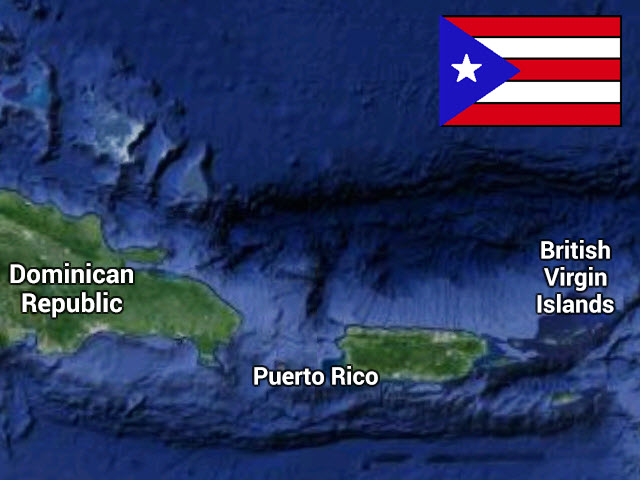Basic Facts
Capital: San Juan
People/Customs: Population 3.5 million, with over 1,147 people per square mile. Puerto Rico does not have its own Major League baseball team, but over 200 famous baseball players came from Puerto Rico to play in the U.S. The people, culture and food are a unique mixture of Spanish, Indian and African.
Language: Spanish/English
Climate: Tropical, with an average temperature of 85°F in July and 80°F in January. Average yearly precipitation: 50 in. Hurricane season June-December.
Food/Farming: sugar cane, coffee, bananas and plantains, mangos, passion fruit, papayas, cattle, tobacco, fish, shellfish, dairy, poultry, salt, and rum.
Government: Puerto Rico is a commonwealth in association with the United States, and the people are U.S. citizens, however, they do not pay federal income taxes and do not vote in U.S. Presidential elections. It is self-governing with an elected governor and a legislature with a house of representatives and a senate.
Currency: Puerto Rico uses the American dollar
Art/Music/Culture: People in Puerto Rico often dance to music at festivals, including Bomba, Plena, and Salsa. Festivals and holidays include: Carnival (February) , Coffee Harvest Festival (February), Orange Festival (March), Dulce Sueño Paso Fino Horse Show (March), Emancipation Day (March), Casals Festival (June), Bomba y Plena Festival (June), Aibonito Flower Festival (June), San Juan Bautista Day (July), Barranquitas Artisans Fair (July), Loíza Festival (July), Festival of Santiago Apóstal (September), International Billfish Tournament (September), Inter-American Festival of the Arts (October), Columbus day (October), Puerto Rican Music Festival (November), Jayuya Indian Festival (November), Discovery Day (December), Hatillo Festival of the Masks (December).
History
In 1493, on his second voyage to the New World, Columbus landed in Puerto Rico, where he and his conquistadors proceeded to harass and enslave the Taínos, the natives to the island, when they could not lead him to the gold that the Spaniards were looking for. In 1509, Juan Ponce De León was selected to be Puerto Rico’s first Spanish colonial governor. His bones lie in Old San Juan today.
‘Puerto Rico’ is Spanish for ‘rich port.’ This was certainly true in the 16th and 17th centuries, when Spain used the island as a re-stocking port to and from the shores of south and central America, where it plundered Aztec and Inca gold and shipped it home. Puerto Rico was a popular spot with pirates, as well, also looking for a “piece of the pie,” so to speak. Later, sugar cane plantations produced another kind of gold: liquid gold in the form of rum. With the end of slavery in 1873, the trade in sugar, slaves and rum ended.
American troops invaded Puerto Rico in July of 1898 during the Spanish-American War. In the Treaty of Paris, Puerto Rico was ceded to the U.S. To this day, it retains its commonwealth status, won by the first elected governor, Luis Munoz Marin in 1951; it is part of the United States and yet independently-governed, uniquely Caribbean with Spanish and African roots. Today, Puerto Rico’s economy is based not on agriculture, but on tourism and manufacturing. Many large American businesses, which relocated to the island to receive tax breaks, left when the tax breaks ended. Puerto Rican debt has ballooned, and the island is in the middle of a decade-long economic recession. Because it is neither a state nor an independent nation, its fate lies in the hands of decision-makers in Washington D.C.
Land Forms/Flora and Fauna
Puerto Rico is mountainous, with the northern half of the island lush and green, and the southern half more arid with grassland. It is covered largely by tropical rain forest, and is home to 56 endangered species. The coqui is a small tree frog that makes a distinctive sound and is unique to Puerto Rico. The highest point on Puerto Rico is on Cerro de Punta, over 3,800 feet above sea level.
Things To Do
Luis A. Ferré Science Museum, Caparra Ruins, Castillo de San Cristóbal, Museum of the Americas, Pablo Casals Museum, Roberto Clemente Coliseum, Muñoz Rivera Park, Museo de Doña Fela, Arecibo Observatory, Parroquia del Espíritu Santo y San Patricio, Luquillo Beach, Culebra Natural Wildlife Refuge, Casa Cautiño Museum, El Faro, Caja de Muertos Nature Reserve, Church of San Blas de Illescas of Coamo, Coamo Historic Museum, La Parguera Phosphorescent Bay, Guánica Dry Forest, Ponce Museum of Art, Hacienda Buena Vista, Parque de Bombas, Birthplace of Luis Muñoz Rivera, Montoso Gardens, Caguana Ceremonial Ball Courts Site, Toro Negro Forest Reserve, Parque de Diversiones el Castillo, Church of San Germán Historic District, Iglesia de Porta Coeli, Los Morillos Lighthouse, Cabo Rojo National Wildlife Refuge, Rio Camuy Cave Park, Juan A. Rivero Zoo, Mona Island, Yague Theater, Ricón Lighthouse Observation Park, El Yunque National Forest, Viejo San Juan, Casa Bacardi Rum Tour.
Bibliography
Pavlidis, Stephen J. A Cruising Guide to Puerto Rico. 2015: Seaworthy Publications, Cocoa Beach, FL.
Stille, Darlene. Puerto Rico. 2009: Children’s Press, New York.

